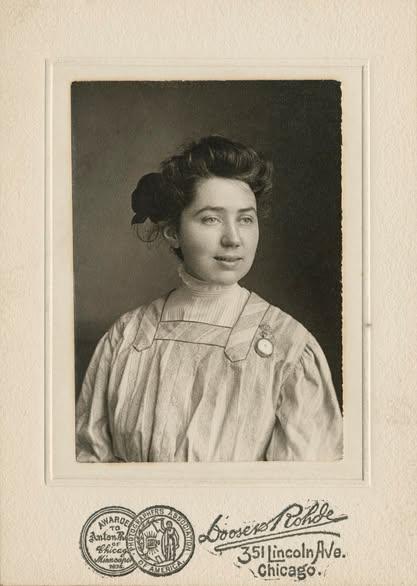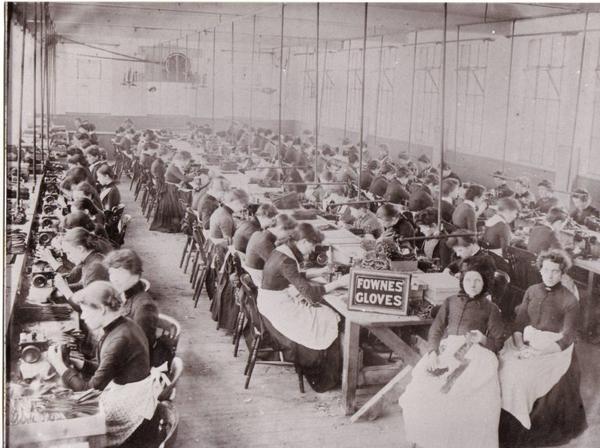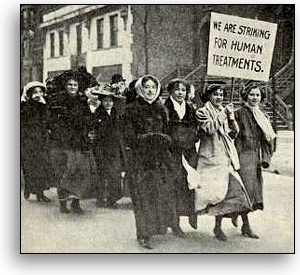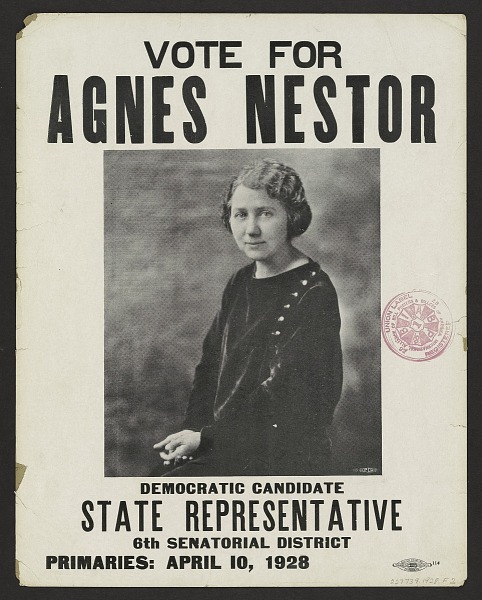January 3, 2025 Hello , Greetings in the new year! In 2025, we're going to find ways (large and small) to support and protect what we most care about. One thing that gives me hope is that thousands of people across our country have organized since 2016. Local and national human rights groups are now much better prepared for resistance and we are not underestimating the threat of the MAGA agenda and the billionaires backing it. More on
that in News and Links below. But first, here’s the story of a woman who understood the power of people standing together and spent her life leading by example.
Meet this Moment with Unity & Action
"I have been so tired all day I could hardly work.” Again and again, teenager Agnes Nestor confided this
in her diary. At 14, she worked 60 hour weeks at the Eisendrath Glove Company in Chicago.
Agnes Nestor, Chicago History Museum, c. 1898 For ten hours a day, she and the other girls and women sat at their sewing
machines and stitched together gloves. It was called piece work, meaning they were paid according to each glove they finished. Agnes' group, the glove closers, challenged themselves to finish a dozen pairs of gloves in an hour in order to earn as much money as they could. They pooled their pennies to buy an alarm clock and hung it on the wall where they could glance at as they worked to stay on
schedule.
Rows of women sewing gloves at a factory similar to the one
where Agnes worked. Worcester, UK Late 19th Century, (equalvisioncic.co.uk) But, though we all seemed happy at first," Agnes wrote later, "gradually it dawned dimly within us that we were not beating the piecework system; it was beating us. Every week when they got their paychecks, fifty cents was deducted for the use of their sewing machines. They also had to buy their own needles and sewing machine oil. And the foremen harassed them with petty rules such as not letting Agnes sit with her sister at lunch because she worked in
another room. The company continually looked for ways to increase profits and decided to try and increase production by subdividing the work. Each worker would be
assigned to sew one smaller part of each glove. The women feared a decrease in pay and knew this arrangement would make their work more monotonous. One group of women, the
banders were asked to try the new system. They refused and walked out. Anne's group decided, "We should be loyal to the girls who
had walked out, and we told the foreman that if the company tried to put new girls in the places of the banders, we would walk out, too!" The strike started on Saturday and by Monday company management decided to drop the plan and everyone went back to work. "We had taken a bold step," Anne wrote later. "Almost with spontaneity we had acted in support of one another. Now we all felt tremulous, vulnerable, exposed. With no regular organization, without even a qualified spokesman, how long would such unified action last?" With that thought, Agnes eagerly attended at meeting of the male glove-cutters union the next night along with other women glove makers and within three days most of the women had signed up to join the union. Before the end of the week, management fired a cutter and the men talked of striking in
protest. "We were young and inexperienced in union procedure; and, as I look back now," Agnes wrote, I see that because of that lack of
experience, and because we were newly organized and therefore anxious to use our new organization, we did a rash thing. We started a strike movement in protest at the discharge of the cutter and also for the redress of our own grievances." Agnes emerged as a leader of the group, though prior to this she had not been outspoken. "No more machine rent; no paying for needles; free machine oil; union shop; raises for the cutters who were paid the lowest wages,” she said.
Women garment workers on strike in Chicago, c. 1911. When the strike continued for a week, company management offered to meet the women's demands for higher pay and no charge for the use of the sewing machines, but the women held out. "Our safety and our future, we knew, lay in our union," Agnes wrote. "We decided not to return to work just yet. Meanwhile we doubled our picket line, determined that none of our group should
falter." After only ten days, the company agreed to meet the all the union's demands. Eisendrath Glove became a union shop and the women returned to
work. Over the next year, Agnes tired of the men's leadership in the union and helped found a women's glove workers local and served as president. In time, she became a
leader in the International Glove Workers Union was the first female president elected to head an international labor union. and then Women’s Trade Union League where she sat on the executive board. She became a knowledgeable and skilled negotiator, helping organize unions in other industries, notably the needle trades, but she expanded her efforts on behalf of women in many jobs ranging from milliners to stockyard workers. Her most important achievement was the Illinois Ten-Hour-Day Law of 1909, and the second act that extended this protection to women who worked outside of factories to hotel and restaurant workers. In 1928, she took a stab at politics, but lost her campaign for a seat in the Illinois
legislature.
Campaign poster for Agnes Nestor, Democratic Candidate for State Representative in
1928. The Ralph E Becker Collection of Political Americana (National Museum of American History) Agnes Nestor fought for working women throughout her life, focusing on safe working environments and fair wages. She joined the leading women's suffragists to speak out for women's voting rights. Some credit her influence for workers gaining the national eight-hour-day in 1937. She also pushed for better maternal health care, the right to parental leave and further education. She helped craft the Smith-Hughes Act of 1917, which provided the first federal
aid for vocational education, and arranged the use public schools that were empty in the evenings to hold courses for working women and girls. Some of what Agnes
Nestor fought for nearly a hundred years ago, we still have not gained today. It appears she was one of those rare women who dedicated their entire focus, time and energy to improving the lives of others. Most of us have not been so singularly engaged, but we can follow her example of finding common cause with others to multiply our impact. Like my article today? Please share this email with one person you know.
I've mentioned before how impressed I am with the national group Showing Up for Racial Justice fondly known as SURJ. They are gearing up to resist the MAGA agenda on day one. They're extremely well organized, research based, tech savvy and offer great
training. It's not too late to dive in, get connected and learn about the actions they have planned. Unfortunately, I've had to miss a few of the training sessions and there is no local group yet in Spokane, but it's easy to get caught up and everyone is welcoming. Find a SURJ chapter in your area here... Learn how SURJ organizes white people into multiracial coalitions, how the far right uses whiteness as a weapon of authoritarianism, and lessons learned organizing white working class people in the South. (Learn more in the 5-minutes video below)
If this is not a fit for you, here are some other choices: In Washington State The Washington Immigrant Solidarity Network is organizing to document any ICE activity in the community, and training volunteers for existing rapid response networks that support communities, build pressure to stop
detention and deportation, and ultimately keep families together. To join a Rapid Response Team and/or become a Legal Observer click here. Let me know what you're doing! Email me about more opportunities for organizing and community activism.
Follow me on social media
This newsletter is a reader-supported publication. To support my work, consider becoming a paid subscriber.
Read
a great book? Have a burning question? Let me know. If you know someone who might enjoy my newsletter or books, please forward this e-mail. I will never spam you or sell your email address, you can unsubscribe anytime at the link below. To find out more about my books, how I help students, teachers, librarians and writers visit my website at www.MaryCronkFarrell.com. Contact me at MaryCronkFarrell@gmail.com. Click here to subscribe to this newsletter. |
|
|







